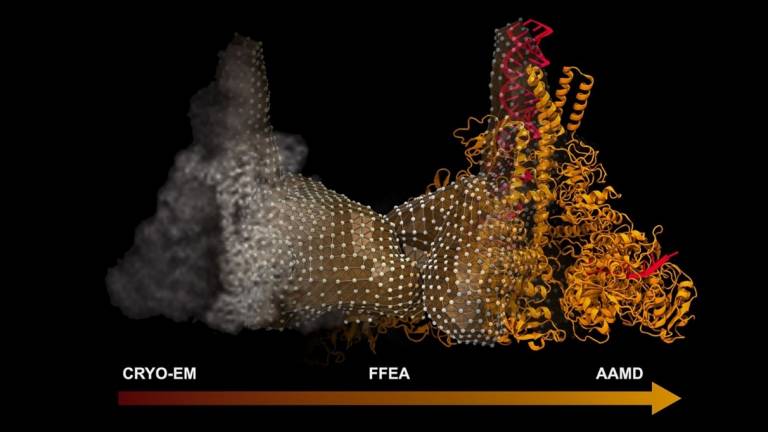UCL and UK scientists part of team nominated for supercomputing prize
19 November 2021
To find weapons to fight the coronavirus, an international group of scientists used the fastest supercomputer in the US to explore the intricacies of how the virus reproduces itself.
The teams work used combinations of AI, molecular dynamics, fluctuating finite element analysis and cryo-electron microscopy data to explore the coronavirus replication machinery.
“Think of it as like a Swiss watch, with precisely organized enzymes and nanomachines that come together like tiny gears to perform this function,” said Arvind Ramanathan, a computational scientist at the U.S. Department of Energy’s (DOE) Argonne National Laboratory and the study’s lead author. Geoff Wells added, “the structural insights from this project will help us to focus our drug design work on the most promising new targets in this large and dynamic multi-protein complex.”
The study earned the multi-institutional team, including Geoff Wells (UCL School of Pharmacy), a finalist nomination for the Association of Computing Machinery (ACM) Gordon Bell Special Prize for High Performance Computing–Based COVID-19 Research. The prize will be presented at this year’s SC21 supercomputing conference, Nov. 14–19.
The coronavirus uses a precisely coordinated process known as the replication-transcription complex to reproduce at high speed when it invades a host’s cells. The process essentially transcribes the ribonucleic acid (RNA), that contains the genetic code for the virus, packages the RNA and pumps out the copies of itself to overwhelm the host cells.
The team used data from cryo-electron microscopy, a technique that flash-freezes molecules and pounds them with electrons to create 3D images, to take a closer look at the molecular machinery. But static images alone wouldn’t be enough to capture the workings of the copying process.
“These simulations helped fill in the blanks the cryo-electron microscopy couldn’t capture and reconstruct the motion that we couldn’t otherwise understand to reach a biophysically meaningful interpretation” said Ramanathan.
The team used a hierarchical artificial intelligence (AI) framework running on Balsam, a distributed workflow engine across four of the US’s top supercomputing systems — Summit, Oak Ridge Leadership Computing Facility’s (OLCF) 200-petaflop flagship computer; Theta, Argonne Leadership Computing Facility’s (ALCF) 15.6-petaflop system; Perlmutter, the National Energy Research Scientific Computing Center’s (NERSC’s) 64.6-petaflop system; and Longhorn, a subsystem of the Texas Advanced Computing Center’s 23.5-petaflop Frontera system — to simulate the process.
The team are sharing the results of their study at the SC21 conference.

By pairing cryo-election microscopy (cryo-EM) with high-performance computing methods including fluctuating finite element analysis (FFEA), all atom molecular dynamics (AAMD) and machine learning, researchers were able to get a detailed view of the SARS-CoV-2 virus.
Image: Argonne National Laboratory/University of Illinois at Urbana-Champaign and used with permission
Further information:
- Argonne National Laboratory
- University of Leeds Astbury Centre for Structural and Molecular Biology
- ACM Gordon Bell Prize
- This research was supported by the Exascale Computing Project, a collaborative effort of the DOE Office of Science and the National Nuclear Security Administration; the COVID-19 HPC Consortium; and the DOE National Virtual Biotechnology Laboratory, with funding provided by the Coronavirus CARES Act, and the DOE Office of Science’s Advanced Scientific Computing Research program. Support is organized under the Co-Design for Artificial Intelligence and Computing at Scale for Extremely Large, Complex Datasets projects.
- The OLCF, ALCF and NERSC are DOE Office of Science user facilities.
- Related Publication: Anda Trifan, Defne Gorgun, Zongyi Li, Alexander Brace, Maxim Zvyagin, Heng Ma, Austin Clyde, David Clark, Michael Salim, David J. Hardy, Tom Burnley, Lei Huang, John McCalpin, Murali Emani, Hyenseung Yoo, Jungyi Yin, Aristeidis Tsaris, Vishal Subbiah, Tanveer Raza, Jessica Liu, Noah Trebesch, Geoffrey Wells, Venkatesh Mysore, Thomas Gibbs, James Phillips, S. Chakra Chennubhotla, Ian Foster, Rick Stevens, Anima Anandkumar, Venkatram Vishwanath, John E. Stone, Emad Tajkhorshid, Sarah A. Harris and Arvind Ramanathan. “Intelligent Resolution: Integrating Cryo-EM with AI-driven Multi-resolution Simulations to Observe the SARS-CoV-2 Replication-Transcription Machinery in Action.” To appear in International Journal of High Performance Computing Applications, 2021.
Contact:
 Close
Close

